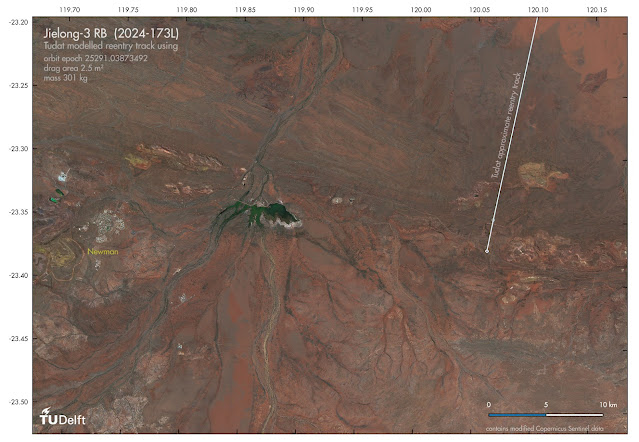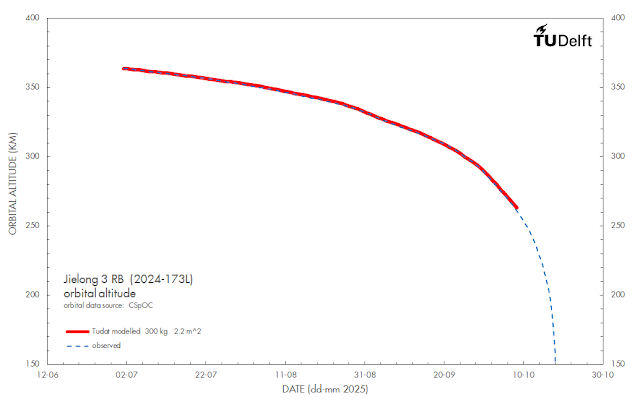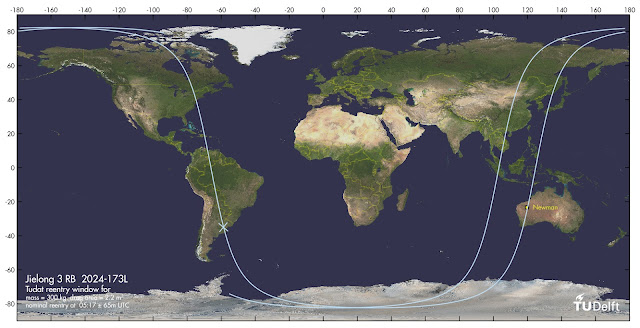On 18 October 2025 near 14:00 local time (= 18 October ~6:00 UTC), a strange object was found on or near a dirtroad in the outback of the Pilbara region in Western Australia. The object, suspected to be space debris, was found some 30 km east of the small mining town of Newman, as reported by ABC.
The object (photo’s in the ABC report) resembles a COPV (Composite-Overwrapped Pressure Vessel), a type of space debris that often survives reentry. It reportedly was burning when found (this seems to be visible in the first photograph in the ABC report), which is unusual and against expectations for space debris. Nevertheless, the character of the object and a good match of the find location to a reentry on 18 October does persuade me to conclude that this is space debris indeed.
A possible candidate for the origin of this apparent space debris is a Chinese Jielong 3 upper stage, catnr. 61237, COSPAR 2024-173L. This object reentered on October 18, although (again! See this recent reentry) no TIP was issued by CSpOC.
I identified the object (note: so independently did Ravi Jagtiani) by assuming the report it was burning, although odd, is true, indicating a very recent impact. Using the latest orbital catalogue I first checked which objects were in orbits below 250 km on October 17-18, i.e. close to reentry, and next I ran a SatEvo analysis on this set to further cull it down to objects that should have been near reentry around that time. Starlink satellites could be excluded given the character of the debris. This left only a handfull of candidates. Of these, only one was in an orbit that would match passing close to Newman in the early hours of October 18: the mentioned Chinese Jielong 3 stage in a 97.6 degree inclined polar orbit. Using a standard SGP4 propagation as a first check, the ground-track would pass some 20-30 km east of Newman around 4:40 UTC on October 18. The rocket stage approached from the north-northeast moving towards the south-southwest.
The last available orbit for 2024-173L is for epoch 25291.03873492 (18 Oct 00:55 UTC), a few hours before the Newman object was found. Using that orbit as a starting point and deploying the reentry model we recently created in the open source Delft University of Technology Astrodynamics Toolkit (Tudat), I tried whether I could get a reentry trajectory to end ~30 km east of Newman.
Not much information is known about the Jielong 3 components in terms of size and mass: therefore, estimates for size and mass of the upper stage had to be used. I assumed a size of about 1.5 x 1.5 meter (cf Jonathan McDowell’s catalogue) and then by trail-and-error varied the mass to get an impact point as close to 30 km due east of Newman as possible.
An impact point situated directly ~30 km east of Newman results when I use a mass of ~301 kg, which seems a reasonable value for a small solid fuel upper stage build from composite. The two maps below show the Tudat modelled reentry trajectory that results from a 2.5 m2 drag surface and 301 kg mass, with impact just after 4:40 UTC on 18 October (see also update II at the bottom of this post):
The modelled impact time is 1 to1.5 hours before the object was reportedly found.
So it looks like the Jielong 3 upper stage 2024-173L is a good candidate for the origin of the possible space debris object found near Newman on October 18. Rather than a COPV from the stage, it could actually be (a significant part of) the upper stage itself, given the large size that the photo’s suggest (and also given that the Jielong 3 upper stage is reportedly a solid fuel stage).
As we have seen with a number of recent reentries, CSpOC alas did not provide a TIP for this object (TIP = “Time of Impact Prediction”, the reentry prediction by the CSpOC reentry model). They did however release an administrative “decay message” for 2024-173L for October 18 just after the reentry, indicating that it did reenter that day.
UPDATE I, 21 Oct 2025 00:20 UTC:
An EU-SST reentry analysis for the Jielong 3 upper stage 2024-173L is in good agreement with my Tudat analysis.
UPDATE II, 21 Oct 2025 15:45 UTC:
Using Tudat, I tried to fit the orbital evolution (based on US tracking data) for 2024-173L from July 1, 2025 to October 15, 2025 to the Tudat model, playing with mass and drag area, to get at empirical values for mass and drag area. One of the solutions that fits well is a mass of 300 kg and drag area of 2.2 m2 , which is close to the values I used to get it to reenter near Newman as described earlier in this blogpost.
With a 300 kg mass and 2.2 m2 drag area, the Tudat reentry model has it nominally surviving untill ~5:17 UTC ± 65 min, nominally reentering half an orbital revolution after passing Newman: but passing Newman actually is well within the uncertainty window of this reeentry prediction (the blue line on the map shows the trajectory over the uncertainty window):
In other words: this too suggests that the object found near Newman could be (a part of) the Jielong 3 upper stage 2024-173L.

![[UPDATED] Possible Space Debris found near Newman, Australia on Oct 18, might be Jielong 3 upper stage remains](https://www.newsbeep.com/ca/wp-content/uploads/2025/10/1761534570_Map_Jielong3rb_18OCT2025_0448UTC_wide_anot.jpg)



